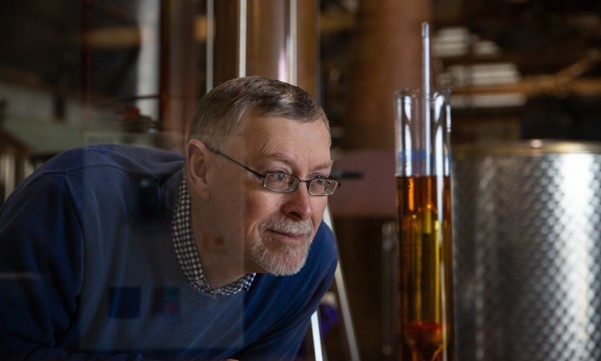
Fleurieu Distilling’s Gareth Andrews inspects an alcometer to measure the strength of a new whisky in production.
WHISKY ON THE RIVER
It’s tranquil within the Steam Exchange Brewery on a chilly mid-week morning. Looking out through the windows of the heritage-listed railway shed, you can see a fog lifting from the river’s mirrored surface.
The silence belies the activity here: a porridge-like whisky wash is bubbling away fermenting, a distillation is just finishing, and hundreds of barrels are silently imparting their flavours to the liquid within. Is this Scotland? No, it’s Goolwa.
Angela and Gareth Andrews established the award-winning Steam Exchange Brewery here in 2004 and that success has translated into their whisky label, Fleurieu Distillery. They started making single malt whiskies in 2013 and have since won numerous awards around the world.
“People come into our cellar door and expect the distillery’s going to be loud and clunky with steam hissing – a giant factory – but it’s quite monastic, especially early in the morning before the cellar door opens. It’s quite peaceful just focusing on what you need to do,” Gareth says.
A former teacher, Angela is Gareth’s co-founder, but she came into the business full time just a few years ago.
“There are so many different aspects to making whisky that I love,” she says.
“Coming in on a brew day with the smell of the malted barley mixing with hot water, or filling a barrel with a whisky that you know is going to be really good.”
The pair were ahead of the craft beer game back in 2004 and making whisky seemed like a natural progression, with everything made in-house from grain to bottle.
“When we moved in to create our own brewery, there were only three breweries in South Australia at the time. You couldn’t just buy equipment, you had to invent it,” Gareth remembers.
“To make good whisky you’ve got to be able to make good beer first because whisky wash is basically beer without hops.”
Gareth believes it is the local Goolwa climate that makes Fleurieu Distillery so unique.
“We call it a terroir; it’s not soil and climate like a vineyard, but the climate that you distil and mature your casks in,” says Gareth.
“It is very humid and damp here because we’re right next to the water; a lot cooler than in Adelaide and that has a large effect on maturation.
“We have a salted caramel character in a lot of our whiskies, and we think that can be attributed to our coastal context. At the end of winter, you can see salt crystals across the top of our barrels. We’re going to start storing some barrels up in the Hills to create a highland whisky and we’ll see what sort of difference that creates.”
The couple’s premium whisky has a recognisable logo that represents their two sons Mitch and Mark. It is also a play on the famous Brussels fountain statue, Manneken Pis.
“The logo captures everything for us about family and the relationship we hope our boys will always have,” says Angela.
“People with some worldly experience recognise the statue and you know straight away who your customer is.”
Fleurieu Distillery Whisky Ginger Recipe
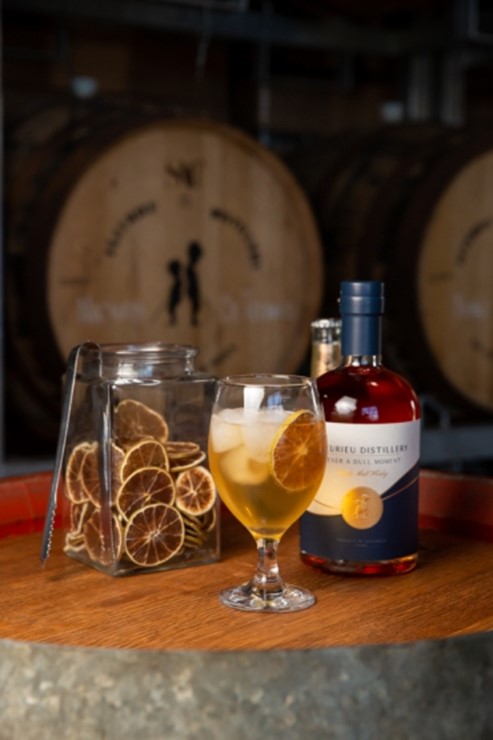
Ingredients:
30ml Fleurieu Distillery Single Malt Whisky
ice
slice of lime (fresh or dehydrated)
Fevertree Dry Ginger Ale
Method: Add whisky and ice into a glass. Pour dry ginger ale to taste and garnish with a slice of lime. Enjoy.
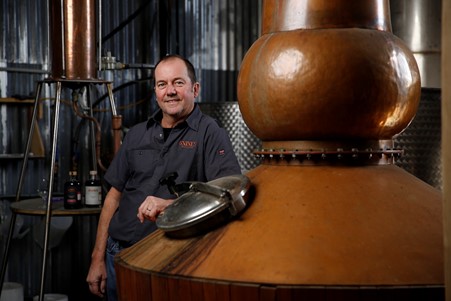
5Nines Distilling co-founder Steven Griguol has become obsessed with the pursuit of the perfect whisky, all made with his hand-built copper still and barrel aged in a range of selected casks at the western suburbs' distillery.
THE WHISKY WHISPERER
Steven Griguol is a creative soul who in his spare time welds and bends steel into sculptures. As co-founder of 5Nines Distilling, whisky has become another extension of his creativity – he even hand-built the distillery’s large copper still.
“It’s exactly that for me; another form of art,” Steven says.
“I love making things out of wood, steel or stone, and making whisky is also about being inventive and creative. There’s a lot of science behind it and although the process itself is simple to grasp, there are nuances to every step.”
Five years ago, Steven started making whisky in a garage with his friend and co-founder David Pearse. Having moved out of the garage and into 5Nines’ western suburbs distillery, Steven has become a true disciple of this cult-like pursuit. There seems to be a commonality between all whisky distillers: an obsessive passion.
Making whisky is a long game that involves steadfast patience, dedication and creativity.
Five nines is a term for the so-called “angel’s share” of spirit that evaporates from each whisky barrel as it ages. It’s also a term for 99.999 per cent, representing Steven and David’s search for perfection.
“There was no real teaching for us; it has always been a learning curve. I like to make the mistakes myself through my own eyes, not through what others are doing,” says Steven.
“You might have two identical barrels filled with the same spirit, sitting in the same spot right next to each other, yet they will come out with two different flavours. That’s part of the fun of it all.”
To produce their premium whisky, 5Nines start with barley sourced direct from a farmer on the Yorke Peninsula. Steven and David have hand-picked their barrels from local wineries – one of their favourites being Sevenhill Cellars, from which they have secured alter wine casks to create their Alter Wine whisky.
“The alter wine barrels beautifully complement the spirit and make what I consider to be the perfect whisky,” says Steven.
“Sherry barrels are amazing as well, they make some of the best whisky out there.”
Some of 5Nines’ whiskies are peated with an Australian coastal peat grass. Steven says non-peated whisky is more accessible to consumers, but the die-hard whisky fans love it. Many of 5Nines’ products are one-offs, never to be repeated in the same way, a key attraction of craft whisky.
Steven wants to help educate consumers to ignore the age on a whisky label. In Adelaide’s Mediterranean climate and fluctuating temperatures, barrels heave and contract rapidly, accelerating the ageing process. He also wants to help consumers find the right type of whisky for them.
“I get so much enjoyment out of the process and you’ve got to be immersed in it to create a good product,” Steven says.
“I look at my barrels and I can still remember the day we filled them years ago; you get emotional about them all.”
5Nines Distilling Whisky Soda Recipe
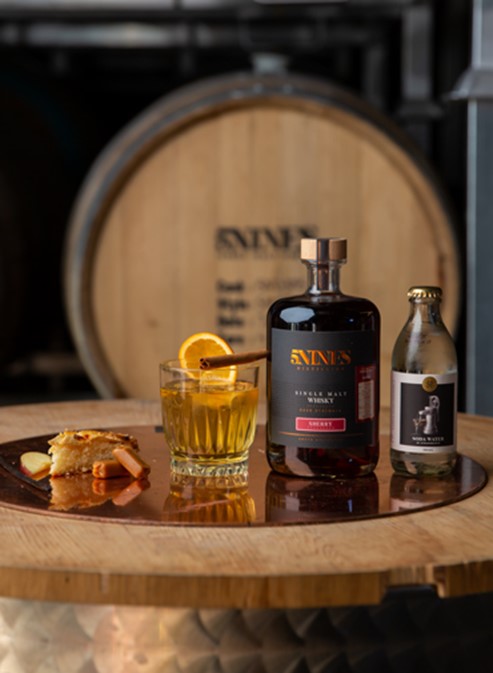
Ingredients:
45ml 5Nines Single Malt Cask Strength Sherry Whisky (Lightly Peated)
Strangelove soda water
ice
orange slice
cinnamon stick
Method:
Pour 5Nines whisky over ice in a glass. Add soda water to your taste and garnish with a cinnamon stick and a slice of orange.
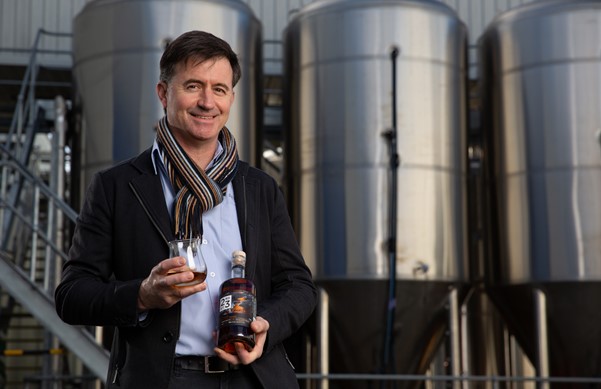
Bickford’s Group Master Blender Chris Dix pictured with 23rd Street Distillery’s new single malt whisky which is made with Kangaroo Island barley. It is said to have notes of toffee, vanilla, apricot, and citrus – appropriate for its Renmark heritage.
TOP SHELF
When most people think of whisky, they might conjure thoughts of barrels collecting dust in a cold, damp Scottish warehouse where no distiller in their right mind would bottle anything less than several years old.
However, in the citrus and grape-growing country of the Riverland, whisky-making is in full swing with results that are sure to raise the eyebrows of traditionalists in the Highlands of Scotland.
Best known for their gin, Renmark’s 23rd Street Distillery – owned by Bickford’s Group – has just released their Batch No. 1 Australian single malt whisky, their first to be distilled and aged entirely in-house.
Bickford’s Group Master Blender Chris Dix believes the local craft whisky industry is on the rise.
“Many professionals, both men and women, are now drinking whisky as a preference and as more smaller distilleries start putting out their product, you’re going to find new whisky cellar doors to visit,” Chris says.
“There used to be about 500 wineries in Australia and now there are thousands of them. Then it happened with craft brewing and gin distilling. I think whisky distillation is the next natural progression.”
Born and raised in Renmark, Chris has 30 years of experience in winemaking and has overseen 23rd Street’s whisky program for several years. Chris is proud of Batch No. 1, which is made with a whisky wash made in partnership with sister business Vale Brewing using Kangaroo Island barley. After fermentation, the mix is distilled between two historic stills.
“The skill of the distiller is to cut the best bit of that distillation. You’ll let the first parts go, which is what we call heads, then we have the hearts which can be anything from 30 to 60 per cent of the run, and then you have the tails. There’s a sweet spot there in the middle that we separate,” says Chris.
The whisky is matured in ex-bourbon barrels across three years and then blended. It is said to have aromas of lime peel, blossom and candied orange, layered over warm butterscotch with nutmeg, allspice and honey notes.
“From the Kangaroo Island barley all the way through to the distillery in the Riverland, it’s very South Australian,” Chris says.
“Our style is all about being an Australian whisky, a little bit citrusy and fruity with some roundness. It is not peated or smokey, but is a dark whisky – there’s no added colouring, it’s purely extraction from the oak and a blending from different barrels.
“As part of a longer-term strategy, we’ve selected some special barrels that we’ll hold onto for a five- or eight-year release. I’ve already tasted and allocated some of those barrels and they look fantastic.”
23rd Street Distillery Whisky Highball Recipe
Ingredients:
45ml 23rd St Distillery Batch No. 1 Australian Single Malt Whisky
30ml lemon juice
soda water
lemon wedge
Method:
Fill a highball glass with plenty of ice. Add in Australian Single Malt Whisky, lemon juice and top with soda water. Garnish with a lemon wedge.
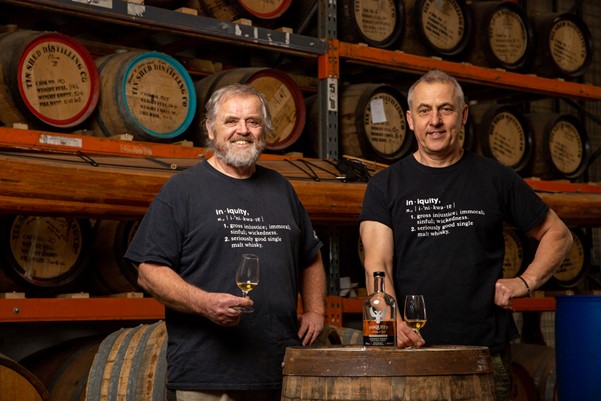
Ian Schmidt and Vic Orlow produce their Iniquity whisky label in the western suburbs, but will later this year open a new distillery and cellar door at Nairne in the Adelaide Hills.
A WORK OF ART
Whisky distillers Ian Schmidt and Vic Orlow are artists of sorts, but instead of a palette of paints they have a shed full of barrels. From ex-bourbon to rum, tawny, apera (sherry), pinot and champagne, each barrel imparts different flavours into the spirit within.
“We have 10 different types of barrels and there is a real artistry to them because you mix them together to create the flavours you want,” Ian says.
Ian and Vic produce premium single malt whisky under their label Iniquity, made and barrel-aged at Tin Shed Distilling in the western suburbs. The business was founded in 2013, but the duo has been making spirits for nearly two decades.
“When we first started in 2004, we were only the second mainland whisky distiller of the modern era,” says Ian.
“But Australia once had a huge whisky industry before the Second World War, and we were one of the biggest producers of whisky in the world.”
Ian, previously a flagpole maker, and Vic, a former chef, became mates while leaning on a fence waiting to pick their children up from school. One day Vic said he wanted to make vodka and – serendipitously – Ian had a still he had inherited from his grandfather.
“We made rum first, but the plan was to make whisky because it’s the premier spirit,” says Ian.
“We just went to a few shows, became educated in different styles of whiskies and it just grew organically.”
Whisky distilling involves hefty start-up costs and no return on investment for at least two years – the minimum time a spirit must be barrel-aged to be called whisky. The Iniquity slogan is “A journey in spirit” which refers to Ian and Vic’s journey of perseverance.
Iniquity whisky is made from scratch using local malted barley grain. South Australian flavours play a key role with their secret ingredient being local peat and mallee root smoke.
“Our smoked peat is our x-factor. Peat is rotting vegetation and in Scotland they have pine needles and sphagnum moss interspersed with a bit of rabbit poop and whatever else comes down the creek. Here, our peat is mostly eucalyptus with gum leaves, wattle leaves, and the odd bit of kangaroo poo all decomposing,” Ian explains.
“We get our peat from a mate called Pete down at Parawa. It lends a whole new South Australian dynamic to the flavour.” The peating process involves smoking the barley grain, which is a similar process to smoking fish.
There are challenges of working in such a hot, dry location, but there are also advantages. “Even though our whiskies are only three to five years old, I believe a 17-year-old Balvenie is a comparable Scottish single malt. We can get a product to market three or four times faster.”
Ian and Vic are establishing a new distillery and cellar door at Nairne, which will be up and running later this year.
“We do like the dryness here, but we think Nairne will lift our quality just a bit higher,” Ian says.
“We actually think that pretty much everyone in South Australia who makes whisky is doing a really good job of it.”
Iniquity Old Fashioned Recipe
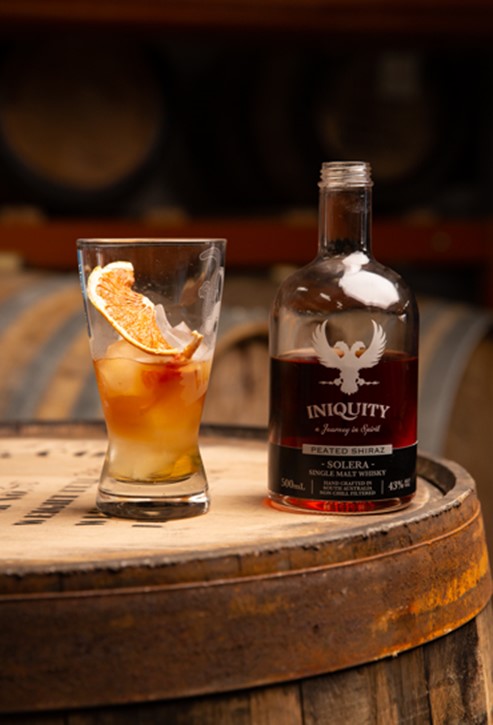
Ingredients:
60ml Iniquity Solera Single Malt Whisky
10-15ml sugar syrup
ice cubes
orange peel
Angostura bitters (optional)
Method:
Add whisky, sugar syrup and ice in a tall glass. Stir and garnish with orange peel or dehydrated citrus. For an extra twist, add 3 dashes of Angostura bitters.
This article first appeared in the September 2022 edition of SALIFE Magazine.
Words & images: Ben Kelly


